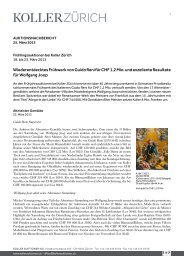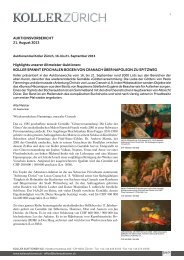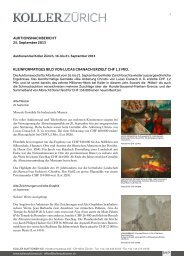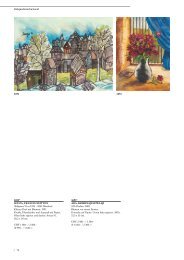Afrikanische Kunst - Koller Auktionen
Afrikanische Kunst - Koller Auktionen
Afrikanische Kunst - Koller Auktionen
Sie wollen auch ein ePaper? Erhöhen Sie die Reichweite Ihrer Titel.
YUMPU macht aus Druck-PDFs automatisch weboptimierte ePaper, die Google liebt.
<strong>Afrikanische</strong> <strong>Kunst</strong><br />
Bamana chi wara (antelope) masked dancers, near Bamako, Mali.<br />
Photograph by Eliot Elisofon, 1971. EEPA EECL 3369. Eliot Elisofon Photographic Archives. National Museum of African Art. Smithsonian Institution<br />
107*<br />
BAMANA HEADDRESS<br />
Mali. H 83 cm.<br />
Provenance:<br />
French private collection.<br />
Published:<br />
Elisofon, Eliot, Fagg, William (1958).<br />
La Sculpture Africaine. New York: Frederick A. Praegr. p. 48, fig. 42.<br />
The most well known Bamana carvings are the abstract antilopes that are<br />
worn on the heads of the dancers of the Ci-Wara Initiation Confraternity.<br />
They refer back to the mythic primeval times when the antilopes, the providers<br />
of culture, brought grain to the people and taught them to cultivate<br />
the fields. Thus, they symbolized the fertility and continued propagation<br />
of the fields as well as of human beings.<br />
The headdresses were used for three different celebrations and always in<br />
pairs: for the weeding competitions, the joyful dances after the completion<br />
of the work in the fields – preceded by the ritual snake hunt, and for the<br />
two-day annual feast of the fraternity, in which among other things the<br />
village was blessed.<br />
Further literature:<br />
Colleyn, Jean-Paul (2001). Bamana. Zurich: Museum Rietberg.<br />
CHF 70 000.- / 80 000.-<br />
(€ 52 240.- / 59 700.-)<br />
| 4<br />
107*<br />
BAMANA AUFSATZMASKE<br />
Mali. H 83 cm.<br />
Provenienz: französische Privatsammlung.<br />
Publiziert: Elisofon, Eliot, Fagg, William (1958). La Sculpture Africaine.<br />
New York: Frederick A. Praegr. Seite 48, Abb. 42.<br />
Die bekanntesten Bamana-Schnitzwerke sind die abstrakten Antilopen<br />
der ci-wara-Initiationsgemeinschaft, die auf dem Kopf der Tänzer getragen<br />
wurden.<br />
Sie spielten auf die mythische Urzeit an, in welcher die Antilope als<br />
Kulturbringer den Menschen das Getreide schenkte und sie den Feldbau<br />
lehrte. Sie standen somit für Fruchtbarkeit und Fortpflanzung sowohl des<br />
Feldes als auch der Menschen.<br />
Die Aufsatzmasken traten anlässlich dreier Feierlichkeiten stets paarweise auf:<br />
beim gelegentlichen Wettjäten, bei Freudentänzen nach der Feldarbeit mit<br />
vorausgehender ritueller Schlangenjagd und beim zweitägigen Jahrfest der<br />
Initiationsgemeinschaft, bei dem unter anderem das Dorf gesegnet wurde.<br />
Weiterführende Literatur:<br />
Colleyn, Jean-Paul (2001). Bamana. Zürich: Museum Rietberg.<br />
CHF 70 000.- / 80 000.-<br />
(€ 52 240.- / 59 700.-)

















